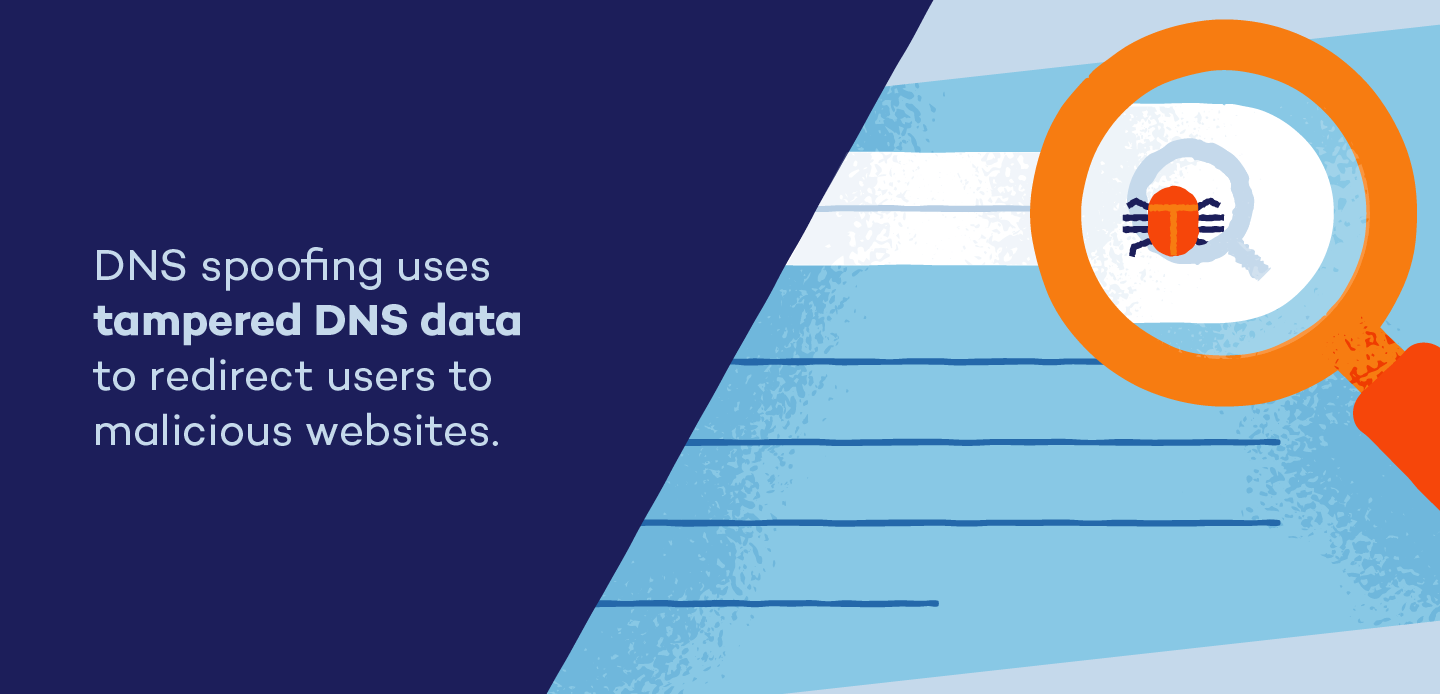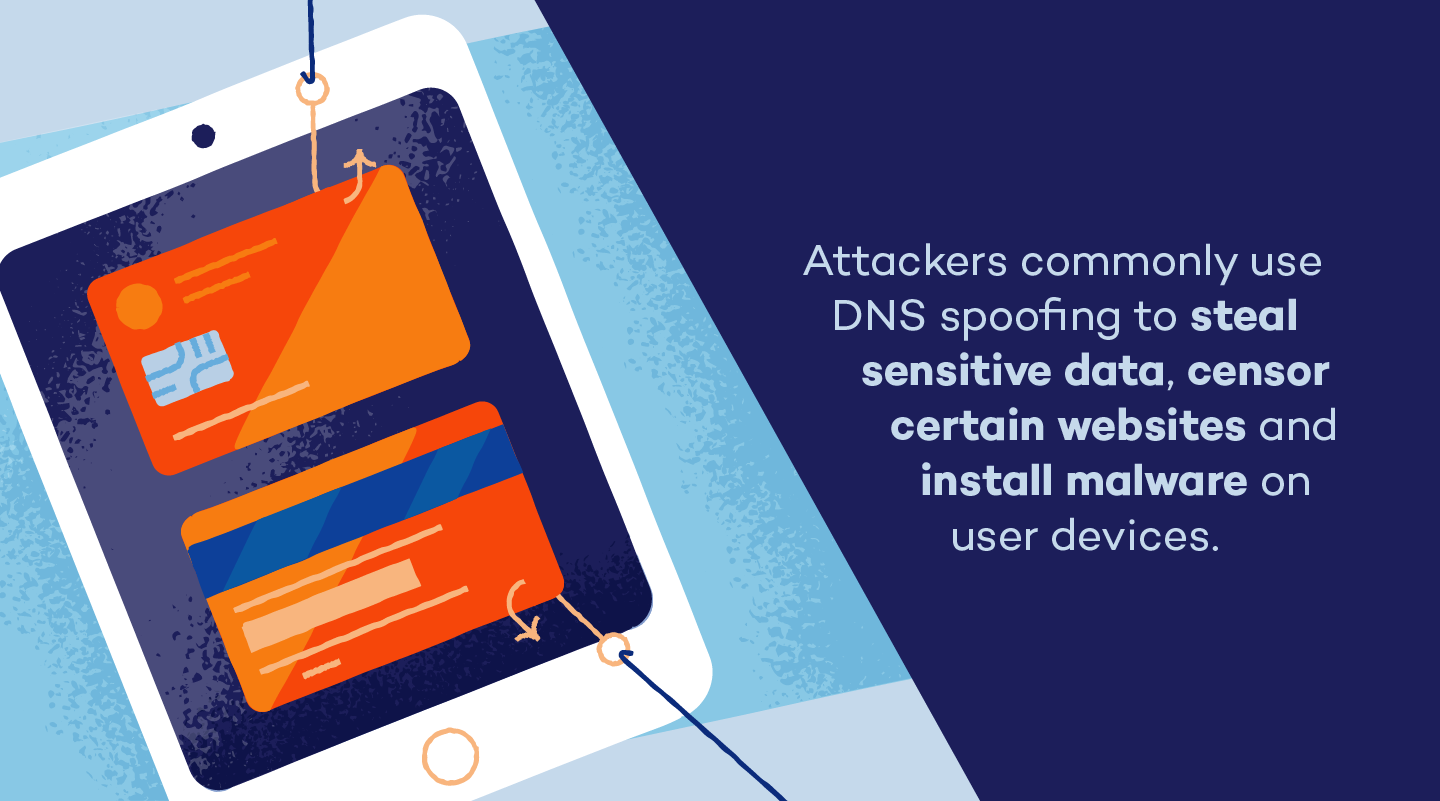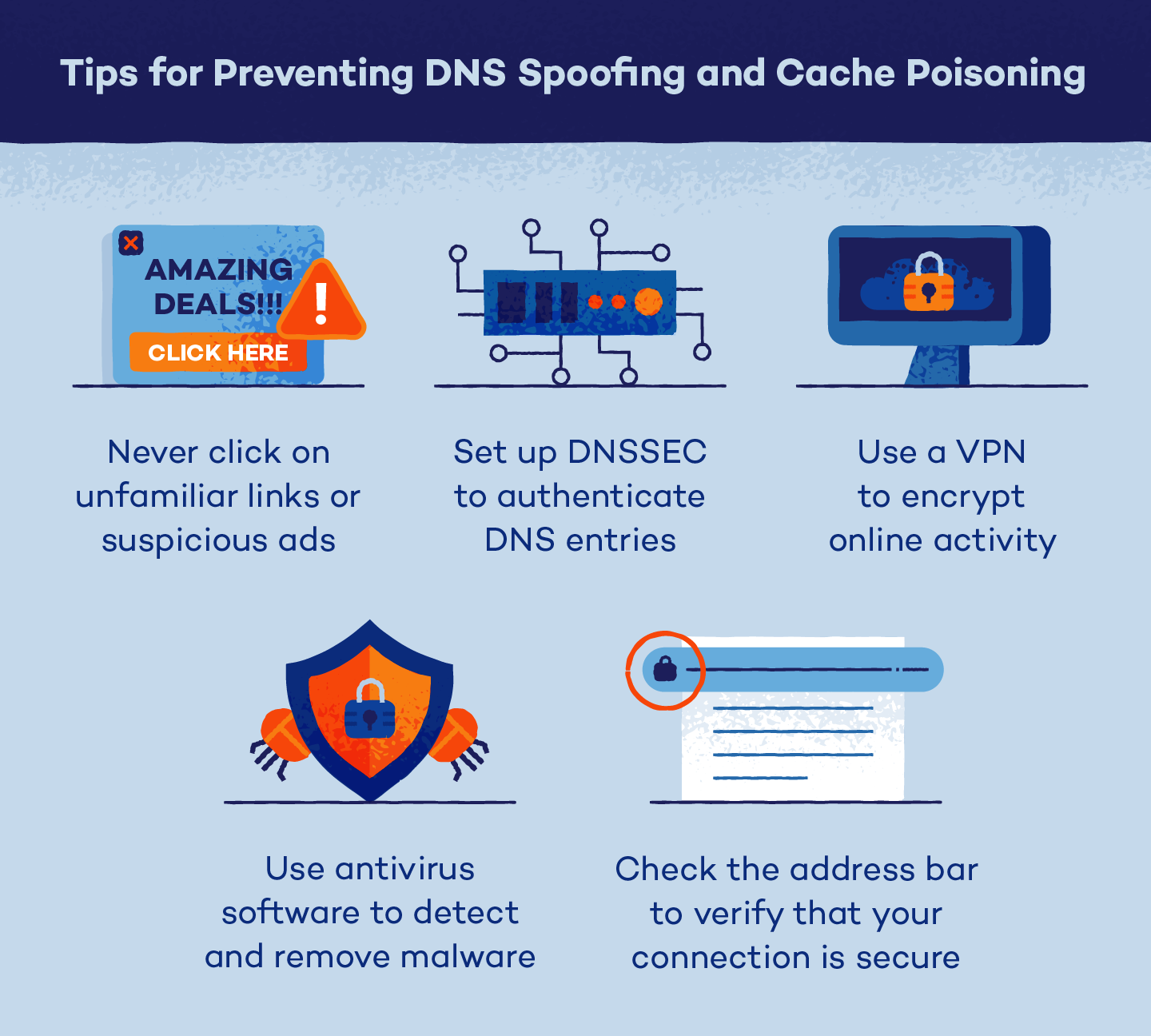
Domain name system (DNS) spoofing is a type of cyberattack that uses tampered DNS server data to redirect users to fake websites. These malicious sites often look legitimate but are actually designed to install malware onto users’ devices, steal sensitive data or redirect traffic.
Before diving into how DNS spoofing attacks work, it’s important to understand how a DNS system operates. When a user searches for a website using a URL (Uniform Resource Locator), their device sends the request to a DNS server that matches the URL to the associated IP address — a unique string of numbers and periods assigned to every device, server and website.
Once the DNS server pairs the request to an IP address, the system directs the user to the requested site. Unfortunately, DNS records are not very secure, and attackers can exploit their vulnerabilities to perform DNS spoofing attacks.
In this article, we’ll explain how DNS spoofing works and provide strategies to identify and protect yourself from an attack.
How Does DNS Spoofing Work?
There are a few methods attackers can use to execute DNS spoofing attacks, but they all share the same goal — to trick users and their servers into thinking a fraudulent website is legitimate. To do this, attackers typically follow these four steps:

Step 1: Accessing the DNS server
Before a hacker can perform this attack, they need to gain access to the DNS server or DNS resolver cache. This process involves identifying a DNS server’s software versioning and MAC address, scanning for vulnerabilities and determining whether it uses DNSSEC (domain name system security extensions) or DNS encryption. Unfortunately, most DNS queries and responses are unprotected, making it easy for attackers to gain access and redirect traffic to a server they control.
Step 2: Rerouting Connections
Once the attacker has access to a DNS server or resolver, they can replace stored IP addresses with fake ones. Because these systems can’t differentiate between a legitimate IP address and a malicious one, attackers can trick them into storing a spoofed entry that leads to a malicious website. Once this process is complete, the spoofed entry remains in the system and directs anyone connected to the server to the malicious site instead of the legitimate one.
Step 3: Accessing Sensitive Data
Once a user arrives at a malicious website, it may prompt them to enter their login information like they normally would. Because the fake site looks exactly like the legitimate one, the victim has no idea that they are handing sensitive information over to the attacker. Attackers can also use DNS spoofing to install malware on a user’s device or redirect traffic to phishing websites. This is especially common for online shopping and banking websites.
Examples of DNS Spoofing Attacks
There are a few different ways attackers can execute a DNS spoofing attack. Some of the most common examples include:
DNS Server Compromise
A DNS server compromise is one of the most common methods for DNS spoofing. In this scenario, an attacker gains access to the DNS server and injects a fake DNS entry. Once the fake IP address is in the system, it directs traffic away from the legitimate site to the malicious one.
A famous example of this type of attack happened in 2018 when hackers compromised Amazon’s Route 53 DNS server and public Google DNS servers. After gaining access, they rerouted roughly 1,300 IP addresses to malicious phishing websites designed to steal user information. One of their biggest targets was the cryptocurrency website MyEtherWallet. Attackers sent users attempting to access their digital wallets to a phishing site and managed to steal around $152,000 during the two-hour attack window.
Man-in-the-Middle Attack
A man-in-the-middle (MIM) attack is a type of cyberattack that hackers use to intercept digital traffic or data transfers and hijack important information. To execute this attack, an attacker intercepts a user’s DNS request before it reaches a legitimate server and reroutes to a fake IP address. This not only sends a spoofed result back to the user and infects their device, but can also poison the DNS server that received the initial request.
DNS Cache Poisoning
DNS cache poisoning is similar to spoofing but takes the attack one step further by infecting a device’s DNS resolver cache. DNS resolvers are designed to save IP address responses for a certain period after the initial request, allowing them to respond to future requests much faster.
Hackers can poison the resolver cache by altering stored data directly or tricking it into storing a forged response. For example, an attacker could change the stored IP address for Twitter.com to one that leads to a fake site they own. When the user searches for Twitter.com, the resolver uses the forged data to send them to a fake site every time they try to access it.
Cybersecurity Risks and Implications
DNS spoofing can pose multiple risks to users. Some of the most common risks include:

Data Theft
Attackers frequently use DNS spoofing to access sensitive user data like banking, credit card and personal log-in information. Phishing websites can be difficult to detect, so users may not notice that their data was compromised until it’s too late.
Censorship
Attackers can use DNS spoofing to censor web results. Some governments intentionally poison DNS caches to prevent citizens from accessing certain websites or online resources. For example, China is known for using DNS hacking as part of its Great Firewall, a DNS filtering system designed to redirect users away from unapproved websites.
Malware Infection
Fake websites are often full of malicious links and downloads that can infect your device with malware. If the spoofed site is an internet security provider, it can indirectly expose you to viruses by preventing legitimate security updates. This risk is highest for users who don’t use antivirus software or other cybersecurity methods.
How to Prevent DNS Spoofing and Cache Poisoning
DNS spoofing and cache poisoning can be difficult to detect since they can affect both user devices and DNS servers. However, individuals and businesses can take steps to reduce their risk of falling victim to an attack.

Never Click on Unfamiliar Links
Malicious websites often display fake advertisements or notifications that prompt you to click on a link. By clicking on unfamiliar links, you could expose your device to dangerous viruses and other malware. If you notice an unfamiliar link or advertisement on a website you normally use, it’s best to avoid it.
Set up DNSSEC
Domain owners and internet providers can set up DNS security extensions (DNSSEC) to authenticate DNS entries. DNSSEC works by assigning a digital signature to DNS data and analyzing a root domain’s certificates to verify that each response is authentic. This ensures that each DNS response comes from a legitimate website. Unfortunately, DNSSEC is not widely used, so DNS data for most domains remains unencrypted.
Scan for and Remove Malware
Because attackers often use DNS spoofing to install viruses, worms and other types of malware, it’s important to scan your devices for these threats regularly. You can do this by installing antivirus software that identifies and helps remove threats. If you own a website or DNS server, you can also install DNS spoofing detection tools. These are designed to scan all outgoing data to ensure it is legitimate.
Use a VPN
A virtual private network (VPN) is an added security measure that prevents attackers from tracking your online activity. Instead of connecting your devices to your internet provider’s local server, a VPN connects to private DNS servers around the world that use end-to-end encrypted requests. This prevents attackers from intercepting traffic and connects you to DNS servers that are better protected from DNS spoofing.
Verify That Your Connection Is Secure
Malicious websites are often identical to legitimate ones at first glance, but there are a few ways to verify that you’re connected to a secure site. If you’re using Google Chrome, look for a small, gray padlock symbol in the address bar to the left of the URL. This symbol shows that Google trusts the domain host’s security certificate and indicates that the website is not a duplicate.
In some cases, your browser will alert you if you try to access an unsecured site. If you see a message warning that your connection isn’t secure, you shouldn’t ignore it. It could mean that the site you’re trying to access is a spoofed site without a legitimate SSL (Secure Sockets Layer) certificate.
DNS spoofing is one of the most difficult types of cyberattacks to detect, but there are plenty of strategies you can use to protect yourself and your information. Consider installing reliable antivirus software or a VPN to help secure your online activity and fend off future attacks.
The post What Is DNS Spoofing and How Can You Prevent It? appeared first on Panda Security Mediacenter.
Article Link: What Is DNS Spoofing and How Can You Prevent It? - Panda Security Mediacenter